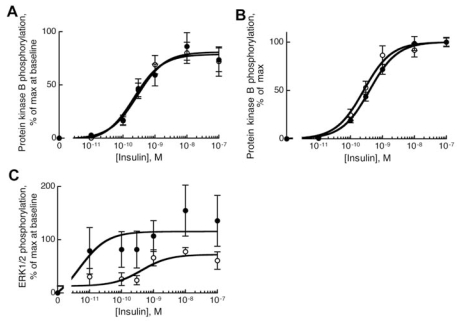Figure 2.
Insulin sensitivity for phosphorylation of protein kinase B (A,B) and MAP-kinases ERK1/2 (C). (A,C) Adipocytes obtained at baseline (open circles) and at the end (closed circles) of the high-calorie overeating period were incubated with the indicated concentration of insulin for 10 min, when incubations were terminated and equal volumes of whole cells were subjected to SDS-PAGE and immunoblotting for phosphorylation of protein kinase B at threonine-308 (A) or phosphorylation of MAP-kinases ERK1/2 (C). Phosphorylation is expressed as a percentage of maximal insulin effect at the start (baseline) of the high-fat diet, mean ± SE (n = 6). Samples from the same subject were analyzed on the same gel. The two curves in (C) were statistically different (P = 0.006, F-test). (B) Adipocytes from patients with T2D (closed circles), age 35–74 years, average 57 years; BMI 28–43 kg/m2, average 34 kg/m2 (n = 16); and from nondiabetic controls (open circles), age 31-94 years, average 58 years; BMI 17–33 kg/m2, average 25 kg/m2 (n = 17), were incubated with the indicated concentration of insulin for 10 min, when incubations were terminated and equal volumes of whole cells were subjected to SDS-PAGE and immunoblotting for phosphorylation of protein kinase B at threonine-308. The phosphorylation is expressed as a percentage of maximal insulin effect in control cells and diabetic cells, respectively, mean ± SE.

